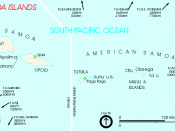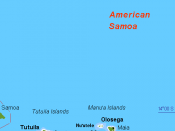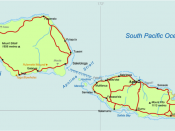SamoaIntroductionTalofa, and welcome to Samoa, the treasured islands of the South Pacific, this is often the catch phrase for the businesses seeking tourists. While Samoa has become a popular and somewhat trendy tourist destination in recent times, it is a more than just that. With historical development, culture and the fa'aSamoa (the Samoan way) at the heart of the Polynesian culture. The volcanic islands of Samoa lie halfway between Hawaii and New Zealand and just to the west of American Samoa. Samoa is comprised of two relatively large islands, Upolu and Savai'i, which account for approximately 96% of the total land area, and eight smaller islands. The capital Apia, and Faleolo International Airport are located on the island of Upolu. Total land area is 2,934 square kilometers. The islands are volcanic and dominated by rugged mountain ranges with a fringe of coral reefs and lagoons that surround the islands. While all of the islands have volcanic origins, only Savai'i has had recent eruptions and can be considered volcanically active.
Samoa's tropical climate and fertile soils offer a wide range of flora from tropical rainforests to scrublands, marshes and swamps. Animal species include flying foxes, land and sea birds, skinks and geckos. In the surrounding ocean, dolphins, whales and porpoises migrate through Samoa's water. The surrounding reefs around the islands are home to some 900 fish species and over 200 varieties of coral.
The eight smaller islands are compromised of Manono, the third most populated island of Samoa. Apolima, the fourth largest, located between Upolu and Savai'i; this island is the rim of an extinct volcano and has one village. Namua is a small tourist island. Fanuatapu is an uninhabited island, but a popular day trip destination. Nuulopa, Nuutele, Nuulua and Nuusafee are the remaining islands and are all uninhabited.


